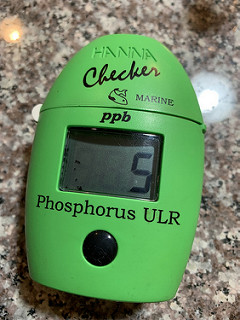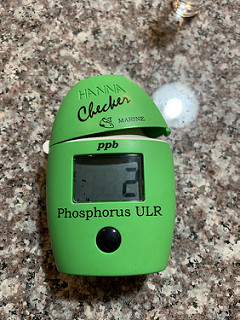Any living organism needs building blocks for growth and repair. Some can recapture and reuse them in a semi-closed system (inside a coral tissue, for example). Zoox is no different than coral which need some building blocks to grow and repair. In an environment with very low building blocks, growth will slow, but death should not happen. All building blocks are poisons at too high of levels - the amount depends on the organism.
Some stuff can run unchecked with higher levels of building blocks, but they also need carbon (sugar) to grow. Most algae are this way and they can make their own sugars. It is true that you can get a lot more algae with more building blocks, but more in the tank (hair, bryopisis is no good) and more in the coral is not really good either (browning from overpopulating). In a brown-out, the coral cannot use all of the sugars created and has to spend energy trying to expel the excess - again, a poison in too high of concentration. This is why growth slows in browned-out corals most of the time and can cause death... I guess a coral type-2 diabetes (I kid).
The ocean has a constant low surplus of N and P... carbon is more scarce unless you have zoox to make some for you. Ocean is at about .1N and .01P, but is really steady with this surplus and does not ever appear to get to zero (although, I do not recall any peer reviewed studies that actually looked at this exact thing).
People hate it when I get all generational, but I will kinda do it here. My apologies in advance... Ever since the Biocube and BRS Generation where people wanted to "control" their tanks from day one, this became an issue. Before this, people tried to get "zero" N and P over the course of the first year, but they did not really mean zero, they meant zero on a cheap, hobby-grade test kit (there was no Hannah Ultra Low Phosphorous back then). Getting to true zero was nearly impossible back then when nobody dosed organic carbon or had GFO... it was a natural low. Over the course of a year, the tank would get a good population of anoxic bacteria in the rocks and sand that would keep the nitrate low, but not too low always leaving enough to drive the equilibrium. The fresh aragonite and rock from the ocean would bind up enough P to leave a small amount in the tank and could act as a buffer to absorb more in between water changes or release more if the levels got low. Most people do not even know that aragonite buffers and binds phosphate. With lack of sand, dry rock (not capable of pulling it's biological weight for quite some time), reactors and chemicals and misunderstanding of chemistry that is mostly driven from manufacturers offering "articles" that support their products as facts, then it has been harder lately to have a really stable tank without waiting a 2-3 years. While any one method is totally doable for the people who do it, the older style of sand, rock, flow, skimmer and patience works and is quite foolproof for the masses. There are far too many people who are fairly new to the hobby who cannot even separate advice for seasoned reefs from advice from new ones... they think that everything applies at all times and that they can always be the exception and not the rule. The easy advice is to wait out the ugly and algae cycles early on, with routine maintenance, until your tank takes shape and is REALLY stable, then try and get a low, but detectable amount of building blocks using a few various methods (one approach for young tanks and another for mature ones) - this is easier said than done with most who want their success now and will just keep buying equipment, chemicals, media, etc. and find a narrative that supports what they want to hear, not what they need to hear, and then wonder why advice or any particular method will not work for them.
Some stuff can run unchecked with higher levels of building blocks, but they also need carbon (sugar) to grow. Most algae are this way and they can make their own sugars. It is true that you can get a lot more algae with more building blocks, but more in the tank (hair, bryopisis is no good) and more in the coral is not really good either (browning from overpopulating). In a brown-out, the coral cannot use all of the sugars created and has to spend energy trying to expel the excess - again, a poison in too high of concentration. This is why growth slows in browned-out corals most of the time and can cause death... I guess a coral type-2 diabetes (I kid).
The ocean has a constant low surplus of N and P... carbon is more scarce unless you have zoox to make some for you. Ocean is at about .1N and .01P, but is really steady with this surplus and does not ever appear to get to zero (although, I do not recall any peer reviewed studies that actually looked at this exact thing).
People hate it when I get all generational, but I will kinda do it here. My apologies in advance... Ever since the Biocube and BRS Generation where people wanted to "control" their tanks from day one, this became an issue. Before this, people tried to get "zero" N and P over the course of the first year, but they did not really mean zero, they meant zero on a cheap, hobby-grade test kit (there was no Hannah Ultra Low Phosphorous back then). Getting to true zero was nearly impossible back then when nobody dosed organic carbon or had GFO... it was a natural low. Over the course of a year, the tank would get a good population of anoxic bacteria in the rocks and sand that would keep the nitrate low, but not too low always leaving enough to drive the equilibrium. The fresh aragonite and rock from the ocean would bind up enough P to leave a small amount in the tank and could act as a buffer to absorb more in between water changes or release more if the levels got low. Most people do not even know that aragonite buffers and binds phosphate. With lack of sand, dry rock (not capable of pulling it's biological weight for quite some time), reactors and chemicals and misunderstanding of chemistry that is mostly driven from manufacturers offering "articles" that support their products as facts, then it has been harder lately to have a really stable tank without waiting a 2-3 years. While any one method is totally doable for the people who do it, the older style of sand, rock, flow, skimmer and patience works and is quite foolproof for the masses. There are far too many people who are fairly new to the hobby who cannot even separate advice for seasoned reefs from advice from new ones... they think that everything applies at all times and that they can always be the exception and not the rule. The easy advice is to wait out the ugly and algae cycles early on, with routine maintenance, until your tank takes shape and is REALLY stable, then try and get a low, but detectable amount of building blocks using a few various methods (one approach for young tanks and another for mature ones) - this is easier said than done with most who want their success now and will just keep buying equipment, chemicals, media, etc. and find a narrative that supports what they want to hear, not what they need to hear, and then wonder why advice or any particular method will not work for them.




















